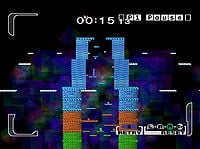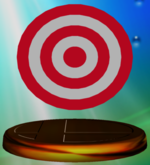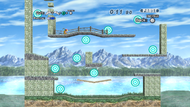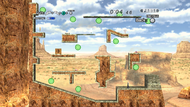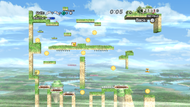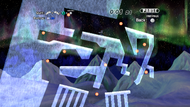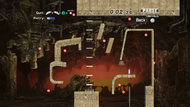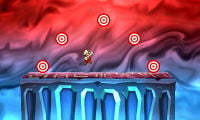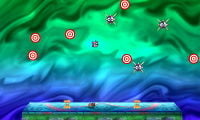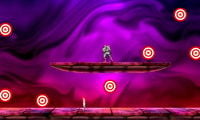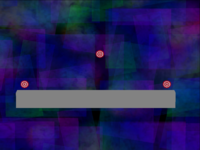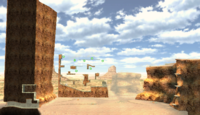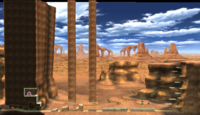Target Smash!
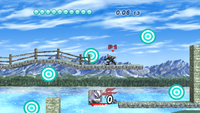
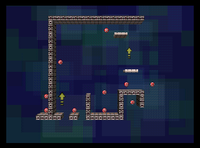
Target Smash!! (ターゲットをこわせ!!, Break the Targets!!), known as Break the Targets! in Super Smash Bros. and Target Test in Super Smash Bros. Melee, is a mini-game appearing in the first four installments of the Super Smash Bros. series. The goal of the game is to smash all 10 targets scattered throughout a special arena as quickly as possible.
The game records the shortest time taken to smash all ten targets. If a character has never smashed all the targets, the game will also record how many targets were smashed in that time. There is also a total time that is kept that includes the cumulative time taken to clear every character's stage, which appears only after all characters have cleared their stage.
Break the Targets! (Super Smash Bros.)[edit]
Each character in SSB has their own target test. Mario's and Donkey Kong's stages resemble the construction girders from the original Donkey Kong, while Luigi's resembles the layout of the Mario Bros. arcade game. Yoshi, Pikachu, and Jigglypuff use light-coloured blocks with grass; Samus, Captain Falcon and Fox use grey-brown metals; and Link, Kirby and Ness use orange bricks. All target tests utilize the unique abilities of their character. For example, Mario's requires him to use his Fireball to smash at least one target.
In 1P Game, during the first Bonus Stage, this mode is announced as Bonus (Practice) 1: Break the Targets").
Glitches[edit]
- Captain Falcon's target test has a section in the lower right where he can pass through the wall.[1]
- Repeatedly pausing and unpausing the game can "jam" the timer and allow the player to move the character without the timer displaying any time as having passed. If done perfectly, the player gains up to two frames to input commands between pauses.[2]
- Breaking the last target at the exact moment that the character passes a blast line will result in both the "Complete" and "Failure" graphics displaying on screen. The time for the target test is still recorded when the player hovers over the character's icon on the target test character select screen.[3]
Layouts[edit]
Unlockables[edit]
- Luigi - Clear Break the Targets! with all 8 starter characters.
Target Test (Super Smash Bros. Melee)[edit]
In Melee, like SSB, every character has their own Target Test. Target Tests often require use of character-specific techniques, for example, Ness is required to use his PK Thunder in order to complete the test. Some characters' Target Tests reference locations in their own series, such as the Ice Climbers' Target Test resembling the levels in their game, and Mario and Donkey Kong's target test loosely resembling the setting of Donkey Kong. Some stages even include images, symbols, or other characters from the character's game (such as the Triforce appearing in Zelda/Sheik's stage and the Condor at the top of the Ice Climbers' stage). Like with the original Smash Bros., the level design may include motifs based on the character's archetype - for example, characters affiliated with royalty may feature Greek columns, and futuristic characters may feature metallic structures.
In Classic Mode, during the first Bonus Stage, this mode is announced as Break the targets! (the exclamation mark is omitted in the PAL version), resembling the original Super Smash Bros.' name.
In Stadium mode, when starting or restarting the stage with a controller in port 1 while holding either or
, a song from the character's universe plays instead of the "Targets" theme. These songs also play for their respective characters during the end credits and after winning Tournament mode.
Layouts[edit]
| Character | Image | Notes |
|---|---|---|
| Mario |  |
Resembles 75m from the Donkey Kong arcade. |
| Dr. Mario |  |
|
| Luigi |  |
Features a Nintendo GameCube as a starting platform. The model for the GameCube is identical to that of its corresponding trophy and features a variety of details that cannot be seen without an unrestricted camera hack, such as an ATI sticker on the front of it. The stage takes place in a largely enclosed area, save for a small gap in the bottom middle part. |
| Peach |  |
|
| Bowser |  |
|
| Yoshi |  |
The design is made of cardboard material similar to Yoshi's Story. |
| Donkey Kong |  |
Has a section that resembles the first level of the Donkey Kong arcade. |
| Link |  |
|
| Zelda/Sheik |  |
Features three Triforces which are arranged to form another Triforce. |
| Ganondorf |  |
Resembles the interior to Ganon's Castle in The Legend of Zelda: Ocarina of Time. |
| Young Link |  |
Resembles Kokiri Forest where Young Link first appears in The Legend of Zelda: Ocarina of Time. Requires Wall jumping to get out of the starting point. |
| Samus |  |
Resembles one of the corridors in the Metroid series. |
| Kirby |  |
The design resembles Green Greens from the Kirby series. |
| Fox |  |
|
| Falco |  |
Features a hazard resembling a Reflector albeit in the shape of an Octagon. |
| Pikachu |  |
Features the same soft platforms from Pokémon Stadium. |
| Pichu |  |
Features swinging platforms with Poké Balls on them. |
| Jigglypuff |  |
The design features a color scheme resembling that of a Poké Ball. |
| Mewtwo |  |
Features red hazards which deal Fire damage and blue hazards which deal Slash damage as a possible nod to Pokémon Red and Pokémon Blue respectively. |
| Captain Falcon |  |
Features a track from Mute City. It also features an image of a pair of dolphins, the same as the one found in Big Blue and in F-Zero X. |
| Ness |  |
|
| Ice Climbers |  |
Based off of a level in Ice Climber. A condor carries one of the targets as a nod to how grabbing it completes the bonus stage in the game. Only one Ice Climber is present. The Icicle Mountain theme plays instead of the usual Targets theme. |
| Marth |  |
The platform textures resemble tile sprites from palaces in the Fire Emblem series. |
| Roy |  |
The platform textures resemble tile sprites from palaces in the Fire Emblem series. |
| Mr. Game & Watch |  |
Takes place on a modified form of Flat Zone, making it the only Target Test to feature a normal stage. The blast lines also act as walls, making it impossible to fail by self-destructing. Unusually, the stage does not actually turn characters into 2D sprites like the actual stage. |
Unlockables[edit]
- Mr. Game & Watch - Clear Target Test with every other character.
- Dream Land stage - Clear Target Test with every character.
- Target trophy - Clear Target Test with every character.
- Lon Lon Milk trophy - Clear every character's Target Test with a total time less than 25:00 (average of one minute per character).
- Sheriff trophy - Clear every character's Target Test with a total time less than 12:30 (average of 30 seconds per character).
Target Smash!! (Super Smash Bros. Brawl)[edit]
Several changes have been made in Brawl, ranging from minor aesthetic alterations to complete functional changes. Most notably, instead of each character having their own one Target test, there are five generic Target Smash stages of varying difficulty that all characters can play on. Increasing difficulties feature smaller targets and bigger stages, making it both harder to break the targets as well as move from one target to another. The color of the targets also matches the difficulty color. Also, each stage of Target Smash is set to be on a specific stage from The Subspace Emissary.
For a first in bonus games, some stages incorporate items. As with most Stadium games in Brawl, Co-op mode is available. Players can now record and save replay footage of their attempts at completing the mini-game.
Some moves that do not inflict damage or require a grab to damage foes can affect Targets:
- Jigglypuff's Sing in Brawl
- Captain Falcon's Falcon Dive and the grab hitbox of Ganondorf's Dark Dive in Brawl
- Wario's uncharged Wario Waft
- Pit's Mirror Shield
Two Target Smash levels are played as bonus stages in Classic Mode. The first occurs after Stage 4, and is the level corresponding to the chosen difficulty. The second is played after Stage 10, the level being one higher than the chosen difficulty (Level 5 again if playing on Intense). When played in Classic, there is a two minute time limit to complete the stages. Once a level is played in Classic, it becomes available in Stadium.
Level 1[edit]
This is a simple course, with very large blue targets, all near each other. It appears to be set in The Lake Shore.
Level 2[edit]
This is somewhat more complex. There are various high cliffs that have green targets at the top. There are also items scattered around the stage. It appears to be set in The Wilds.
Level 3[edit]
This stage is unique as it has a Slide Launcher, a spring, as well as a conveyor belt. It is set in a partial Box. It too has items. It appears to be set in The Swamp.
Level 4[edit]
This level is icy, causing players to slip. Most of the orange targets move, often requiring perfect timing to complete fast enough. There is one non-moving target that is very difficult to get, located at the bottom right of the stage, and for some characters, it has to be gotten last. This stage has no items. It appears to be set in the Glacial Peak or in Summit.
Level 5[edit]
This is the final Target Smash level. It has small red targets, spikes, springs, items, and moving platforms. It appears to be set in The Path to the Ruins.
Unlockables[edit]
All of the challenges associated with Target Smash!! can be broken by a Golden Hammer.
- Lucario - Clear all levels of Target Smash!! with one character.
- Mr. Game & Watch - Clear Target Smash!! with 30 characters.
- Apples Trophy - Clear Target Smash!! level 1.
- Starfy Trophy - Clear Target Smash!! on level 1 with 10 characters.
- Super Scope Trophy - Clear Target Smash!! level 1 with all characters.
- Palutena's Bow Trophy - Clear Target Smash!! level 1 in under 15 seconds.
- Peanut Popgun Trophy - Clear Target Smash!! level 2.
- Pellets Trophy - Clear Target Smash!! level 2 with 10 characters.
- Blast Box Trophy - Clear Target Smash!! level 2 with all characters.
- Excite Truck Music - Clear Target Smash!! level 2 in under 18 seconds.
- Wario Bike Trophy - Clear Target Smash!! level 3.
- Ashnard Trophy - Clear Target Smash!! level 3 with 10 characters.
- Silver the Hedgehog Trophy - Clear Target Smash!! level 3 with all characters.
- Ray MK III Trophy - Clear Target Smash!! level 3 in under 20 seconds.
- Rocketbarrel Pack Trophy - Clear Target Smash!! level 4.
- Musketeer Daltania Trophy - Clear Target Smash!! level 4 with 10 characters.
- King K. Rool Trophy - Clear Target Smash!! level 4 with all characters.
- Cardboard Box Trophy - Clear Target Smash!! level 4 in under 32 seconds.
- Title (3D Hot Rally) Music - Clear Target Smash!! level 5.
- Outset Link Trophy - Clear Target Smash!! level 5 with 10 characters.
- Gray Fox Trophy - Clear Target Smash!! level 5 with all characters.
- Combo Cannon Trophy - Clear Target Smash!! level 5 in under 30 seconds.
In Super Smash Bros. for Nintendo 3DS[edit]
As a stand-alone mini-game, Target Smash has been replaced by Target Blast in both versions of Super Smash Bros. 4. However, a more traditional Target Smash! can appear in three variants - easy, medium and hard - behind Challenge Doors in Smash Run.
Names in other languages[edit]
Trivia[edit]
- In Melee and Brawl, when played from the Stadium menu, the timer runs even when the game is paused.
- In Melee, an early Target Test stage for Sheik can be accessed though the debug menu. The remnants of the stage, however, consist only of a grey platform and three targets placed to form a triangle. Breaking all three targets ends the match.
- In Brawl, Target Smash level 2 takes place in The Wilds, and in the background, a portion of the level can be seen if the camera is zoomed out using an emulator or mods. Interestingly, in addition to some of the obstacles and non-terrain platforms being removed, the skybox was also changed.
- Masahiro Sakurai stated in a YouTube video that he created Break the Targets! as an indirect tutorial to play the characters in lieu of a proper tutorial mode.[4]
- Super Smash Bros. Ultimate is the only game to not have a Target breaking mini-game, nor a variation of it.
References[edit]
| Super Smash Bros. menu items | |
|---|---|
| VS Mode | VS Start (Team Battle) · Rule · Time / Stock · VS Options |
| 1P Mode | 1P Game · Training Mode · Bonus 1 Practice · Bonus 2 Practice |
| Option | Sound · Screen Adjust · Backup Clear |
| Data | Characters · VS Record · Sound Test |
| Unused | Debug menu |
| Super Smash Bros. Melee menu items | |
|---|---|
| Vs. Mode | Melee (Time · Stock · Coin Battle · Bonus · Team Battle) · Custom Rules · Special Melee · Tournament Mode · Names |
| 1-P Mode | Regular Match (Classic Mode · All-Star Mode · Adventure Mode) · Event Match · Stadium (Target Test · Home-Run Contest · Multi-Man Melee) · Training |
| Trophies | Gallery · Collection · Lottery |
| Options | Rumble · Sound · Screen Display · Language · Erase Data |
| Data | Snapshots · Melee Records · Sound Test · Archives (NTSC only) · How to Play (PAL only) |
| Unused | Debug menu · Debug sound test menu |
| Super Smash Bros. Brawl menu items | |
|---|---|
| Group | Brawl (Time · Stock · Coin Battle · Team Battle) · Rules · Special Brawl · Rotation · Tourney · Names |
| Solo | Classic · All-Star · Adventure Mode: The Subspace Emissary · Events · Stadium (Target Smash!! · Home-Run Contest · Multi-Man Brawl · Boss Battles) · Training |
| Wi-Fi | Spectator Mode · With Anyone · With Friends |
| Vault | Trophies & Stickers (Trophy Gallery · Trophy Hoard · Coin Launcher · Sticker Album · Sticker Center) · Stage Builder · Album · Challenges · Replays · Masterpieces · Chronicle |
| Options | Screen · Deflicker · Rumble · Controls · Sound · My Music · Erase Data |
| Data | Movies · Records (Group Records · Brawl Records · Notices) · Sound Test |
